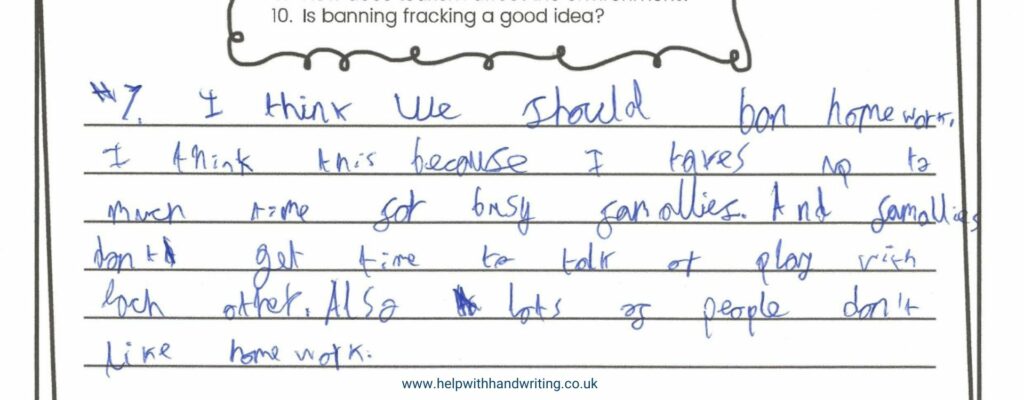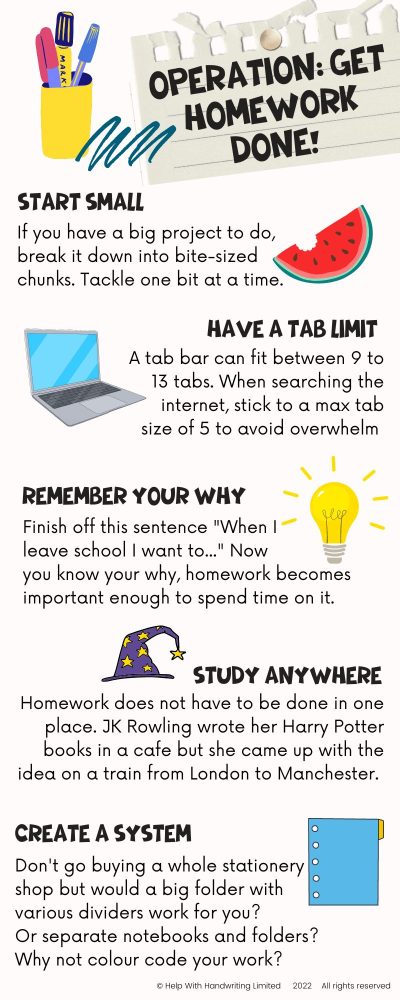Homework is such a controversial topic.
Responses such as the ones below are often seen.
I think homework should be banned. It pushes people off the subject and does the opposite to promote learning.
Homework is often completed at home where a student should be relaxing and enjoying time with their friends. Instead they are forced to complete useless tasks.
I think homework should be abolished. It does not help them in any way. It only increases the workload of pupils and puts them under stress.

In this post, we will cover why having a homework routine is important. Ask 5 key questions. They will help you decide if the problem is with handwriting or homework. Take a look at 6 strategies as a parent you should take to establish a homework routine. Identify five strategies your child and learn to do. Discuss three mistakes parents make around homework. Concluding with our views on homework.
Why getting a homework routine right will change your life (well make it easier!)
Getting homework right is not about completing assignments. Homework is crucial. It shapes a child’s academic journey and growth. It serves as a bridge between classroom learning and independent study. It helps to reinforce key concepts and fosters critical thinking skills.
Teaching good homework habits early on has long-term benefits. They go far beyond the classroom. It helps children learn essential time management skills, discipline and responsibility.
Being proactive about homework can greatly impact a child’s success in school. Most kids start a homework routine at ages 5 to 7. This is when school has spelling tests. From ages 7 to 11, it is crucial to watch how handwriting affects a child’s homework. Handwriting is key for tasks like note-taking and doing assignments. It is also key for expressing ideas on paper. Any difficulties in this area can impact their overall academic performance.
You’ll be pleased to hear that student attitudes towards homework do change. Where once homework was the worst thing anyone could ask another person to do. By the GCSE years, many students no longer believe that it is an unnecessary evil. Some even admit that it can be beneficial.
Questions to ask yourself to decide if the homework is difficult due to your child's handwriting

If you answered yes to any of these questions check out how our individual handwriting lessons can help your child improve their handwriting. If your child is left handed you will find this blog super helpful.
6 Strategies to Establish a Successful Homework Routine for Your Child
1. Be a good motivator and monitor
It is a horrible feeling when you find something tricky. Everyone feels this from time to time. At these times, we want to shout from the rooftops, “I can’t do it anymore!”. Homework should never feel this way. The teachers won’t be setting any work your child can’t do. Remind them that making their best effort is better than not doing it. No one is seeking perfection. Keep being that encouraging voice that they need to hear. By all means, help them but make sure you don’t end up doing it for them.
2. Time Blocking
As its name suggests, time blocking allows them to break the work they need to do into manageable chunks. This means they can zero in on a single task instead of switching from one thing to the next. Thus completing it in a fraction of the time. It is also essential to time block personal time (aka gaming time). To get started, ask them to try dedicating 15 to 30 minutes to one subject. It can be helpful to think of it as imposing a limit on how much time they spend on their work. They might like this way of thinking!
3. Let them share their knowledge with you.
Sometimes it can be helpful to get an answer wrong intentionally. As they age, this becomes easier and less of a planned error. Even so, it is empowering for your child to share their new knowledge with you. As this helps instil enjoyment in learning.
4. Do the opposite.
This is when you use reverse psychology. The aim is to encourage your child to maintain their homework schedule. This is a form of manipulation but is excellent for strong-willed tweens and teens. Remind them of the consequence. For example, “don’t do your homework, that is fine with me, but you may fall behind. I would never use the ‘fail’ word because there is a result of a failure that is difficult to come back from. However, implying you’d fall behind has implications. It suggests you might fail an end-of-year exam, but it is not verbalised.
5. Create a plan of attack.
Don’t be afraid of natural consequences. Sometimes we need to learn what happens if we do not do the homework on time. Is it lost marks or a reduction in house points? Perhaps it is worse… detention? Part of growing up is being able to explain and reason our actions. Gone are the days when we could say, “The dog ate my homework, Miss”. The key thing to establish is your child is unwilling to do it. Or did they forget because they didn’t have a ‘system’ to help them? During the teen years, planning and organisational skills are still developing. You can help them create a system (aka a plan of attack). It’ll help them manage homework deadlines. This could be done by scheduling due dates on their phone with set reminders. Or you could go ‘old school’ with a whiteboard or planner.
6. Consider renaming it?
Just because it’s called ‘homework’. It doesn’t have to happen all at home. Assignments can occur anywhere. If you have a busy household, the work can happen at school or during a study period (if they have one). If a friend understands a topic better than you, they could work together. It can be more enjoyable with some healthy snacks – healthy ones!
Things your child can do to help themselves with their homework

How to motivate them to do their work
There are two types of motivation – intrinsic and extrinsic.
Intrinsic is when someone finds motivation to do something for themselves. For example, a child works on their handwriting. They can see the difference it makes to how their writing looks.
Extrinsic motivation comes from external factors. They give someone a reason to do something. Dare I even say it but in the past ‘punishments’ were threatened. I recall the days of hearing “If you do not do your homework you will not get X, Y or Z” in my childhood. It didn’t encourage me. If anything it made me want to dig my feet in further to refuse to do whatever I was being asked to do. Extrinsic methods don’t work and it has a temporary effect. However, I will admit that sometimes there is a place for both. For example, a reward chart is an external motivator. But, if they like to please their parent by doing well at handwriting, you’ve combined the two elements.

3 Mistakes to avoid when asking your child to do their homework
1. Avoid saying “It’s your job to do homework”
Have you ever said, “It’s your job to do homework” and then regretted it? Sometimes we can say things that we didn’t intend to. When we think of a ‘job’, not everyone jumps for joy and goes, ‘Yes, I’d love to do that today!’. Referring to homework as a ‘job’ brings negative emotions. Consider reframing this as an opportunity to learn rather than an obligation.
2. Using bribery
It can be so tempting to use bribery as a little extra encouragement. “If you do your homework for at least 30 minutes, then you can have…”. Whether it be more time gaming or a nice supper it just doesn’t work. Unfortunately, it usually backfires as it reduces any motivation to learn. For example, offering extra screen time for completing a handwriting practice worksheet gets done because of the screen time being offered. Your child will not see the value or enjoyment in what they are doing. Also if you offer money this could be a very expensive mistake to make, not just for now but in the future.
3. Comparison with others
There is a time and place to compare handwriting and doing it when reviewing homework can be tricky. When the homework topic is new or tricky to learn writing quality can change. It can appear to deteriorate. That is because a child is over concentrating on what they are writing about. Comparisons can also cause unnecessary pressure or anxiety. It also overlooks strengths highlighting individual weaknesses.
And my views about homework
I often hear of older students spending their whole weekend doing homework. This is not healthy. They are either hiding in their bedrooms and are on their video games, or they are lost and unsure of what to do next. No homework should ever take this long.
I think homework is a necessary evil, particularly with handwriting. Often with handwriting, students have habits that are not helpful. The only way to make fundamental changes is through practice. If we don’t practice, we won’t get to the goal post of having readable handwriting. Homework doesn’t have to be boring, which is what we pride ourselves on. Here at Help with Handwriting, we try to make handwriting fun. We also make sure that applies to any of the homework that we set. Here are some ways we make our handwriting homework fun.

If you think your child needs some of our handwriting help you can read more about our handwriting lessons and how we will engage them here. Are you concerned about how online lessons can work, read our ‘be ready for lessons’ advice blog. Or uncertain whether it’s worth investing time to improve your child’s handwriting, we’ve got that covered too! Find out more here.









